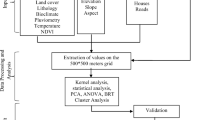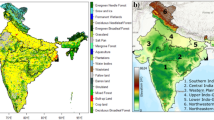Abstract
Fire is a significant component of most boreal forest ecosystems. It is important to understand its occurrence and spread to assess the potential impact of global climate change on boreal forest ecosystems. This chapter presents an overview of our understanding of the processes and models that have been developed and used to predict both people-caused and lightning-caused fire occurrences in the boreal forest. We draw heavily on our experience with fire occurrence in the boreal forest region of Canada, but some of our observations may be applicable to other parts of the circumpolar boreal forest as well as other biomes.
Access this chapter
Tax calculation will be finalised at checkout
Purchases are for personal use only
Preview
Unable to display preview. Download preview PDF.
Similar content being viewed by others
References
Bergeron, Y., and M.D. Flannigan. 1995. Predicting the effects of climate change on fire frequency in the southeastern Canadian boreal forest. Water Air Soil Pollut. 82:437–444.
Blackmarr, W.H. 1972. Moisture Content Influences Ignitability of Slash Pine Litter Research Note SE-173. Southeastern Forest Experiment Station, U.S. Department of Agriculture, Forest Service, Asheville, NC.
Blake, I.F. 1979. An Introduction to Applied Probability. John Wiley & Sons, New York.
Bradshaw, L.S., J.E. Deeming, R.E. Burgan, and J.D. Cohen. 1984. The 1978 National Fire-Danger Rating System: Technical Documentation. General Technical Report INT 169. Intermountain Forest and Range Experiment Station, U.S. Department of Agriculture, Forest Service, Ogden, UT.
Caya, D., R. Laprise, M. Giguère, G. Bergeron, J.P. Blanchet, B.J. Stocks, J.G. Boer, and N.A. McFarlane. 1995. Description of the Canadian regional climate model. Water Air Soil Pollut. 82:477–482.
Cunningham, A.A., and D.L. Martell. 1973. A stochastic model for the occurrence of mancaused forest fires. Can. J. For. Res. 3:282–287.
Cunningham, A.A., and D.L. Martell. 1976. The use of subjective probability assessments concerning forest fire occurrence. Can. J. For. Res. 6:348–356.
Flannigan, M.D., and J.B. Harrington.1988. A study of the relation of meteorological variables to monthly provincial area burned by wildfire in Canada (1953–80). J. Appl. Meteorol. 27:441–452.
Flannigan, M.D., and C.E. Van Wagner. 1991. Climate change and wildfire in Canada. Can. J. For. Res. 21:66–72.
Flannigan, M.D., Y. Bergeron, O. Engelmark, and B.M. Wotton. 1998. Future wildfire in northern forests: less than global warming would suggest? J. Veg. Sci. 9:469–476.
Forestry Canada Fire Danger Group. 1992. Development and Structure of the Canadian Forest Fire Behaviour Prediction System. Informal Report ST-X-3. Forestry Canada, Science and Sustainable Development Directorate, Ottawa, Ontario, Canada.
Fuquay, D.M., R.G. Baughman, A.R. Taylor, and R.G. Hawe. 1967. Characteristics of seven lightning discharges that caused forest fires. J. Geophys. Res. 72:6371–6373.
Fuquay, D.M., A.R. Taylor, R.G. Hawe, and C.W. Schmid, Jr. 1972. Lightning discharges that caused forest fires. J. Geophys. Res. 77:2156–2158.
Fuquay, D.M., R.G. Baughman, and D.J. Latham. 1979. A Model for Predicting Lightning Fire Ignitions in Wildlands Fuels. Research Paper INT 217. USDA Forest Service, Intermountain Forest and Range Experiment Station, Ogden, Utah.
Garcia, C., C. Vega, P.M. Woddard, S.J. Titus, W.L. Adamowicz, and B.S. Lee. 1995. A logistical model for predicting the daily occurrence of human caused forest fires. Int. J. Wildland Fire 5:101–111.
Harrell, F.E., Jr. 1986. The LOGIST procedure, pp. 269–293 in R.P. Hastings, ed. SUGI Supplemental Library User’s Guide. SAS Institute Inc., Cary, NC.
Hartford, R.A. 1990. Smoldering combustion limits in peat as influenced by moisture, mineral content, and organic bulk density, pp. 282–286 in D.C. Maclver, H. Auld, and R. Whitewood, eds. Proceedings of the 10th Conference on Fire and Forest Meteorology, April 17–21, 1989, Ottawa, Ontario. AES, Downsview, Ontario, Canada.
Higgins, D.G., and G.S. Ramsey. 1992. Canadian Forest Fire Statistics. Information Report PI-X-107. Forestry Canada, Petawawa National Forestry Institute.
Houghton, J.T., G.J. Jenkins, and J.J. Ephraums, eds. 1990. Climate Change-The IPCC Scientific Assessment. Cambridge University Press, Cambridge, UK.
Kourtz, P., and B. Todd. 1991. Predicting the Daily Occurrence ofLightning-Caused Forest FiRes. Informal Report PI-X-112. Forestry Canada, Petawawa National Forestry Institute, Chalk River, Ontario, Canada.
Latham, D.J. 1983. LLAFFS-A Lightning Locating and Fire-Forecasting System. Research Paper INT 315. USDA Forest Service Intermountain Forest and Range Experiment Station, Ogden, UT.
Latham, D.J. 1987. Design and Construction ofan Electric Arc Generatorfor Fuel Ignition Studies. Research Paper INT 366. USDA Forest Service, Intermountain Forest and Range Experiment Station, Ogden, UT.
Latham, D.J., and J.A. Schlieter. 1989. Ignition Probabilities of Wildland Fuels Based on Simulated Lightning Discharges. Research Paper INT 411. USDA Forest Service, Intermountain Forest and Range Experiment Station, Ogden, UT.
Lee, E.T. 1980. Statistical Methods for Survival Data Analysis. Lifetime Learning Publications, Belmont, CA.
Lupo, A.R., R.J. Oglesby, and I.I. Mokhov. 1997. Climatological features of blocking anticyclones: a study of Northern Hemisphere CCM1 model blocking events in presentday and double CO2 concentration atmospheres. Clim. Dyn. 13:181–195.
Martell, D.L. 1990. A Markov chain model of a forest fire danger rating index, pp. 225–231 in D.C. Maclver, H. Auld, and R. Whitewood, eds. Proceedings of the 10th Conference on Fire and Forest Meteorology, April 17–21, 1989, Ottawa, Ontario. AES, Downsview, Ontario, Canada.
Martell, D.L., S. Otukol, and B.J. Stocks. 1987. A logistic model for predicting daily people-caused forest fire occurrence in Ontario. Can. J. For. Res. 17:394–401.
Martell, D.L., E. Bevilacqua, and B.J. Stocks. 1989. Modelling seasonal variation in daily people-caused forest fire occurrence. Can. J. For Res. 19:1555–1563.
Newark, M.J. 1975. The relationship between forest fire occurrence and 500 mb longwave ridging. Atmosphere 13:26–33.
Overpeck, J.T., D. Rind, and R. Goldberg. 1990. Climate-induced changes in forest disturbance and vegetation. Nature 343:51–53.
Poulin-Costello, M. 1993. People-caused forest fire prediction using Poisson and logistic regression. MSc thesis, Department of Mathematics and Statistics, University of Victoria, Victoria, British Columbia, Canada.
Price, C., and D. Rind. 1994. The impact of a 2 x CO2 climate on lightning-caused fires. J. Clim. 7:1484–1494.
Rothermel, R.C. 1972. A Mathematical Model for Predicting Fire Spread in Wildland Fuels. Research Paper INT 115. USDA Forest Service, Intermountain Forest and Range Experiment Station, Ogden, UT.
Shindo, T., and M.A. Uman. 1989. Continuing current in negative cloud-to-ground lightning. J. Geophys. Res. 94:5189–5198.
Stocks, B.J., B.D. Lawson, M.E. Alexander, C.E. Van Wagner, R.S. McAlpine, T.J. Lynham, and D.E. Dube. 1989. The Canadian forest fire danger rating system: an overview. For Chron. 65:258–265.
Stocks, B.J., M.A. Fosberg, T.J. Lynham, L. Mearns, B.M. Wotton, Q. Yang, J.-Z. Jin, K. Lawrence, G.R. Hartley, J.A. Mason, and D.W. McKenney. 1998. Climate change and forest fire potential in Russian and Canadian boreal forests. Clim. Change 38:1–13.
Uman, M.A. 1987. The Lightning Discharge. Academic Press, San Diego, CA.
Van Wagner, C.E. 1987. Development and Structure of the Canadian Forest Fire Weather Index System. Forest Technical Report 35. Canadian Forestry Service, Ottawa, Ontario, Canada.
Walker, W.E., J.M. Chaiken, and E.J. Ignall, eds. 1979. Fire Department Deployment Analysis: A Public Policy Analysis Case Study-The Rand Fire Project. North-Holland, New York.
Weber, M.G., and M.D. Flannigan. 1997. Canadian boreal forest ecosystem structure and function in a changing climate: impact on fire regimes. Environ. Rev. 5:145–166.
Williams, E.R. 1992. The Schumann resonance-a global tropical thermometer. Science 256:1184–1187.
Wotton, B.M., and M.D. Flannigan. 1993. Length of the fire season in a changing climate. For. Chron. 69:187–192.
Editor information
Editors and Affiliations
Rights and permissions
Copyright information
© 2000 Springer-Verlag New York, Inc.
About this chapter
Cite this chapter
Anderson, K., Martell, D.L., Flannigan, M.D., Wang, D. (2000). Modeling of Fire Occurrence in the Boreal Forest Region of Canada. In: Kasischke, E.S., Stocks, B.J. (eds) Fire, Climate Change, and Carbon Cycling in the Boreal Forest. Ecological Studies, vol 138. Springer, New York, NY. https://doi.org/10.1007/978-0-387-21629-4_19
Download citation
DOI: https://doi.org/10.1007/978-0-387-21629-4_19
Publisher Name: Springer, New York, NY
Print ISBN: 978-1-4684-9532-4
Online ISBN: 978-0-387-21629-4
eBook Packages: Springer Book Archive




